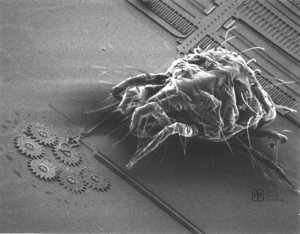Let’s play a little game i like to call “What if…”.
Today’s topic: nanotechnology, its slowly dying champion, and his robotic fountain of youth.
Meet the protagonist, futurist Ray Kurzweil. once hailed as “the restless genius” by the Wall Street Journal and “the ultimate thinking machine” by Forbes, he now dominates the growing field of commercial artificial intelligence. A recipient of the the 1999 National Medal of Technology (America’s s highest tech honor), twelve honorary doctorates, and honors from three U.S. presidents, Kurzweil may actually be remembered for none of these things, given his fantastic vision of the future. In fact, he may never be “remembered” at all.
Kurzweil’s plan: never die.
the man with the plan
 A lofty goal, you might say. For most, that’s probably true. But Kurzweil is different. Somehow his vision of the future seems almost bizarrely accurate…and inevitable. In Ray’s future, the robots don’t kill off the humans or harvest them for energy, they actually are the humans…nanotechnologically-enhanced humans who can basically live forever.
A lofty goal, you might say. For most, that’s probably true. But Kurzweil is different. Somehow his vision of the future seems almost bizarrely accurate…and inevitable. In Ray’s future, the robots don’t kill off the humans or harvest them for energy, they actually are the humans…nanotechnologically-enhanced humans who can basically live forever.
Now i know it sounds like this guy pages “doctor spock” just a little too often, but we’re talking about 22nd century science here, and in his defense, the future is shaping up to be pretty darn impressive. Leading industry players like Dupont Chemicals are already making nanotech-inspired industrial paint that dries when you expose it to ultraviolet light for even a few seconds, and companies like IBM are already developing carbon nanotubes that are 100 times stronger than steel and only one-sixth the weight. Still others are busy designing microscopic “nanobots” that you can actually inject into your body to scrape all the cholesterol from the walls of your aging arteries. And better yet, they’re designing other little bots to regenerate elasticity in those very same arteries once all the harmful plaque is removed.
Now for those who haven’t yet explored the growing field of microscopic nano-thingys, here’s a free primer from the mind that first developed the concept way back in 1986. Likened to Jules Verne, H.G. Wells and Arthur C. Clarke (among others), K. Eric Drexler basically suggests that what we can do as a species depends entirely on what we can build; on what building blocks we have at our disposal for the creation of everything we use.
And on this rare occasion, smaller really is better.
For starters, once humans can actually start “stacking atoms” (nanotechnology in its purest form), the next 50 years could bring about more technological change than the last 1,000 years. Its applications are virtually limitless, and scientists are already lining up to use the universe’s penultimate building blocks to produce everything from synthetic construction materials to synthetic heart tissue.
That’s where kurzweil fits in.
live long and prosper
“When Computers Exceed Human Intelligence” is the rather aggressive subtitle of Kurzweil’s latest bestseller, The Age of Spiritual Machines. Within its pages, he makes a rather convincing argument about the future of these useful atomic tools, proposing that early medical applications of nanotechnology will involve administering nanobot “healing” agents (like Advil or the morning-after pill) to ward off disease and decay. More significantly, however, the budding science will eventually develop various forms of permanently regenerative tissue that will one day ward off all disease and physical atrophy. Under this vision of the future, all organic humanity will eventually cease to exist as the body continues to “age”, leaving in its place a truly “spiritual” being”, supported by a fully robotic framework of immutable nanobots, each with their own part in maintaining the basic metabolic and athletic requirements of an increasingly synthetic “body”.
In other words, biological immortality.
At the very least, it’s another entertaining flight of futuristic fantasy in the tradition of “War of the Worlds“, “2001: A Space Odyssey” and “20,000 Leagues Under the Sea“. At the very most, it’s the answer to life’s ultimate question. And, perhaps, the question to life’s ultimate answer.